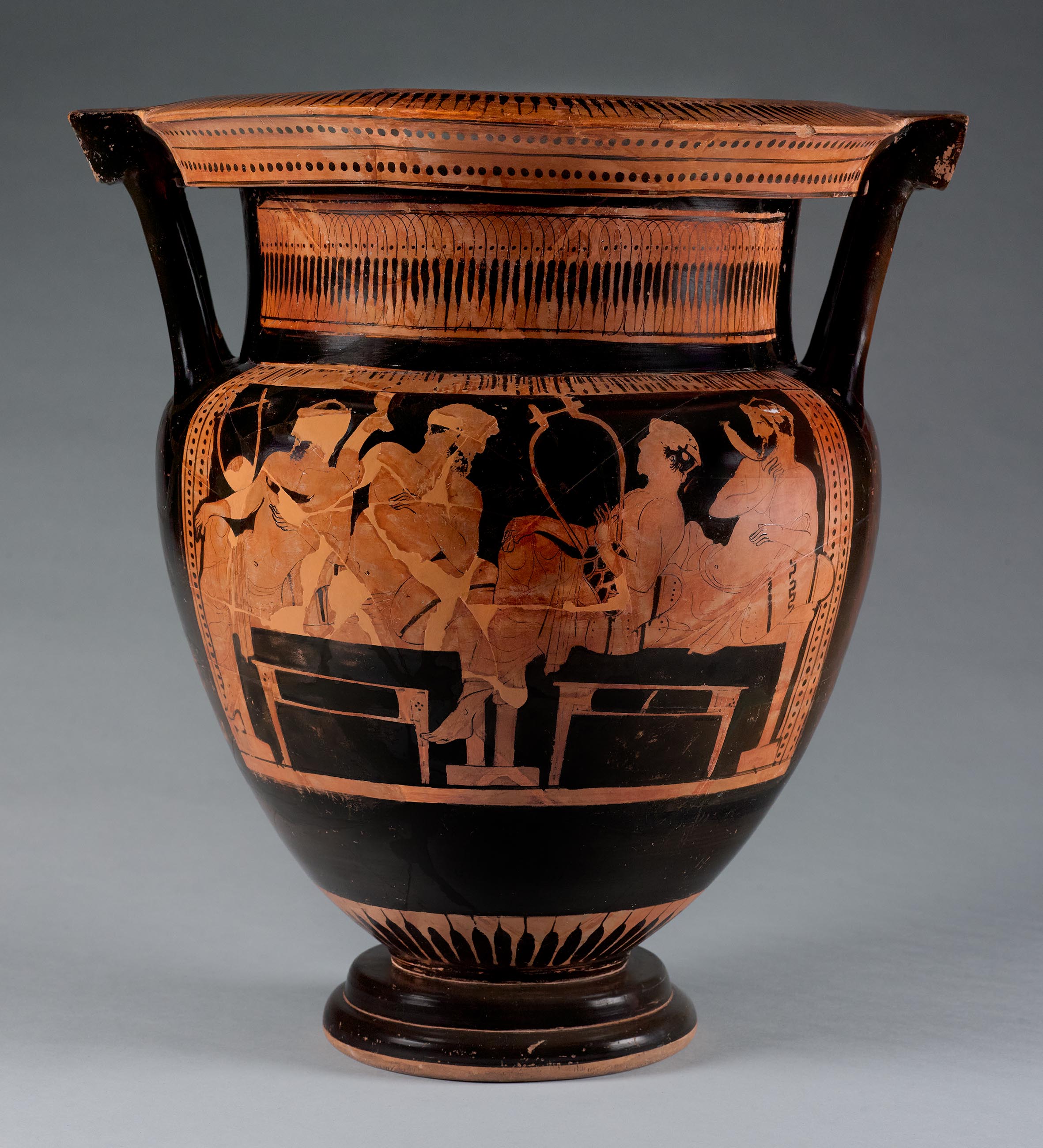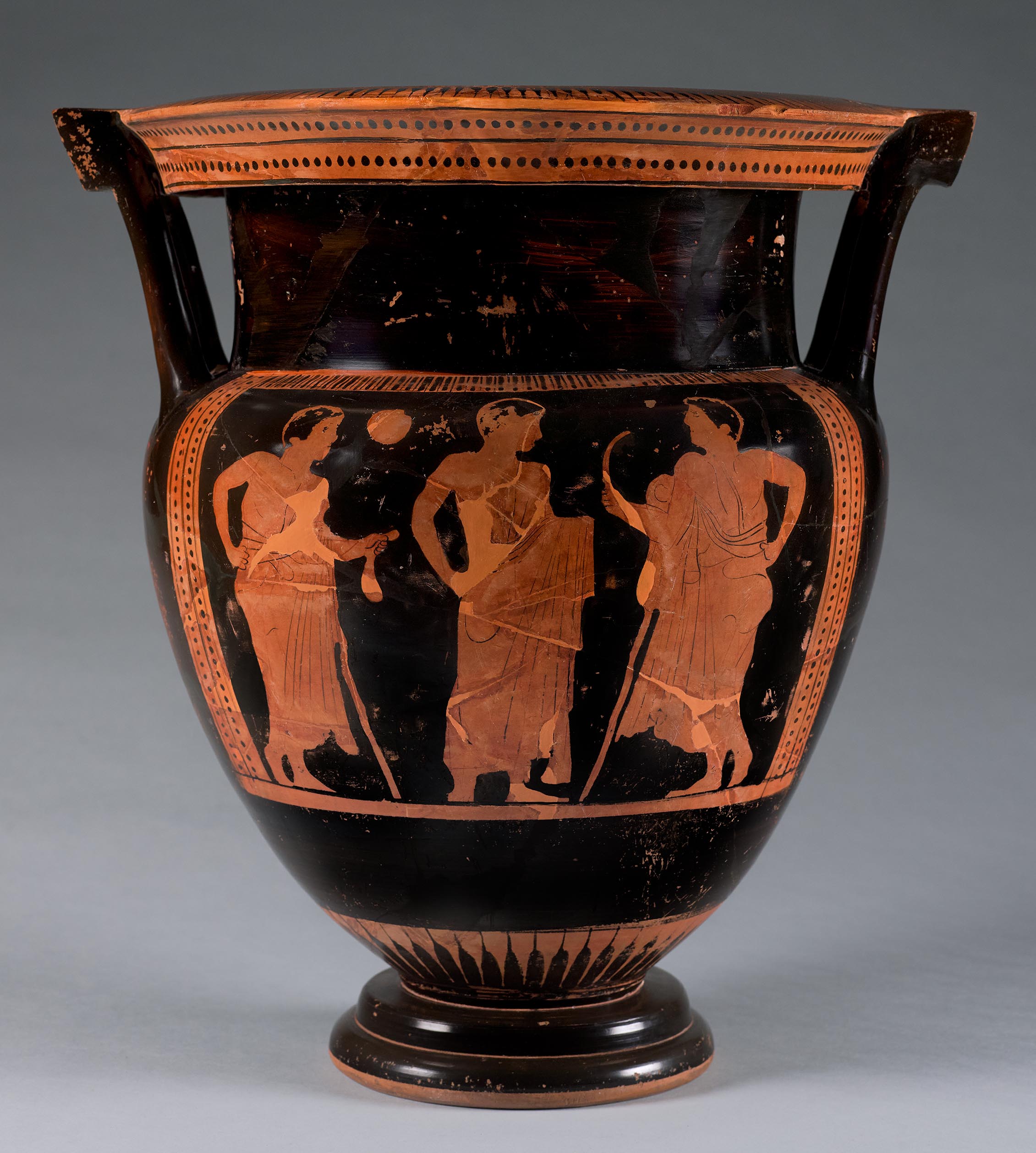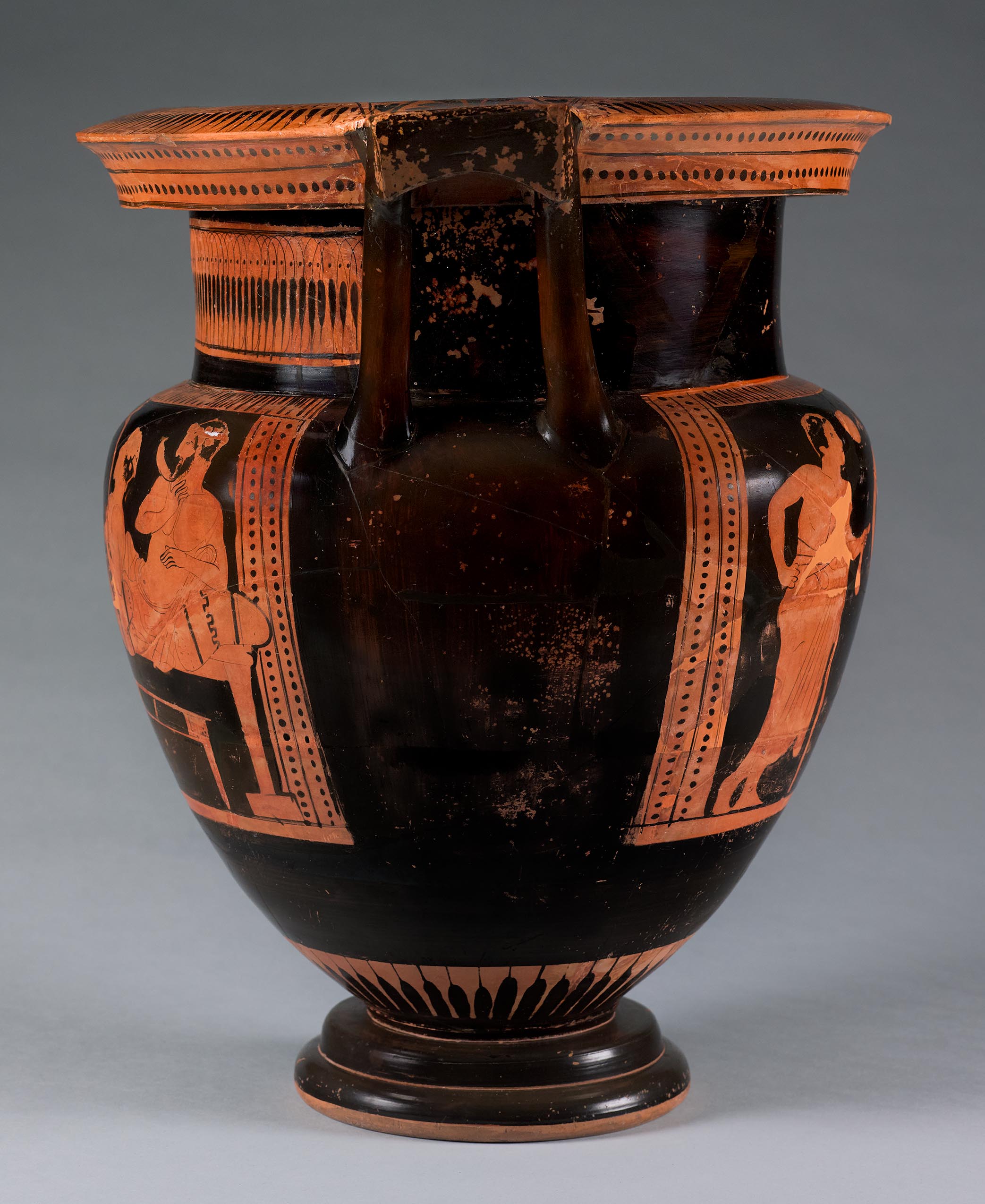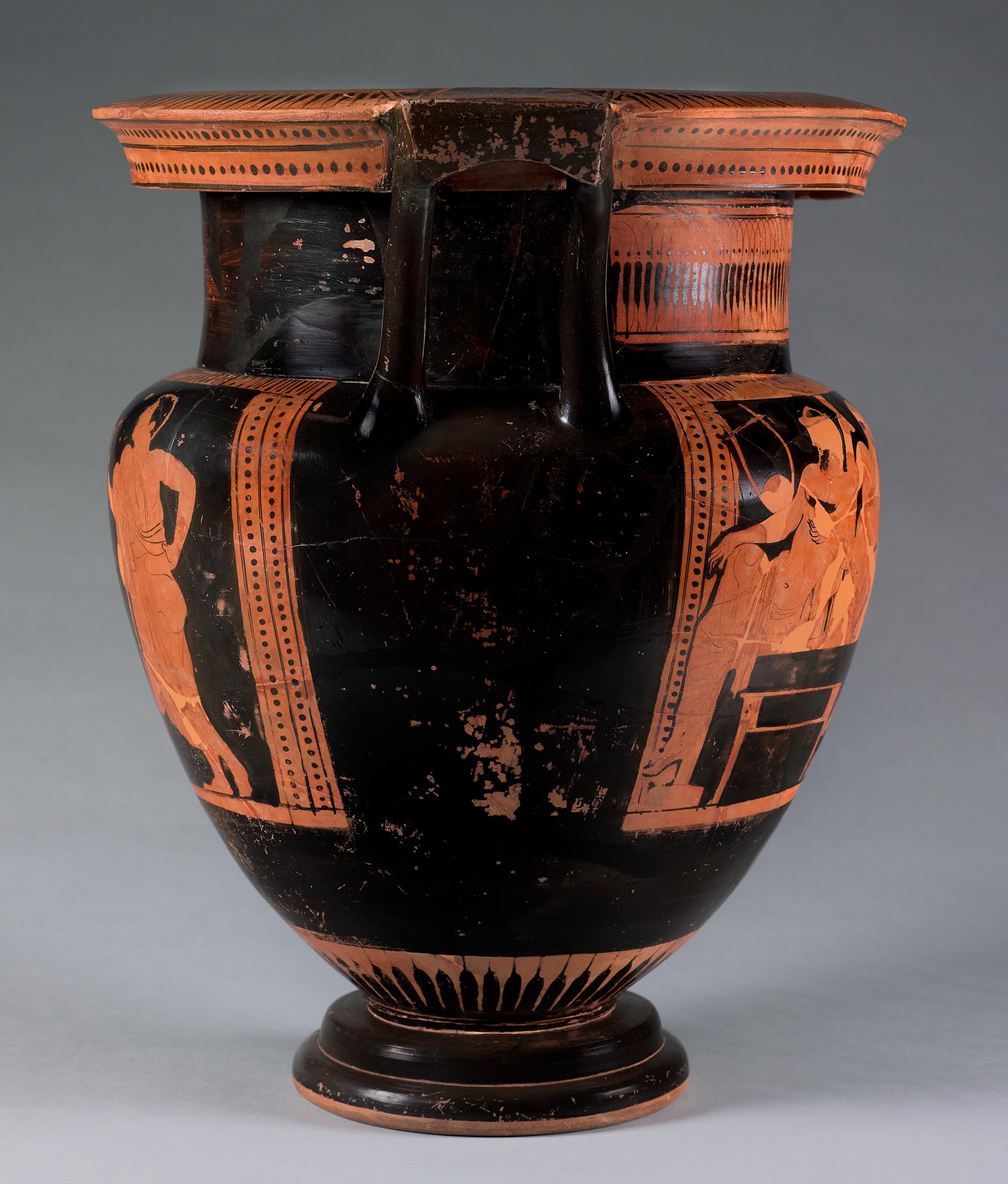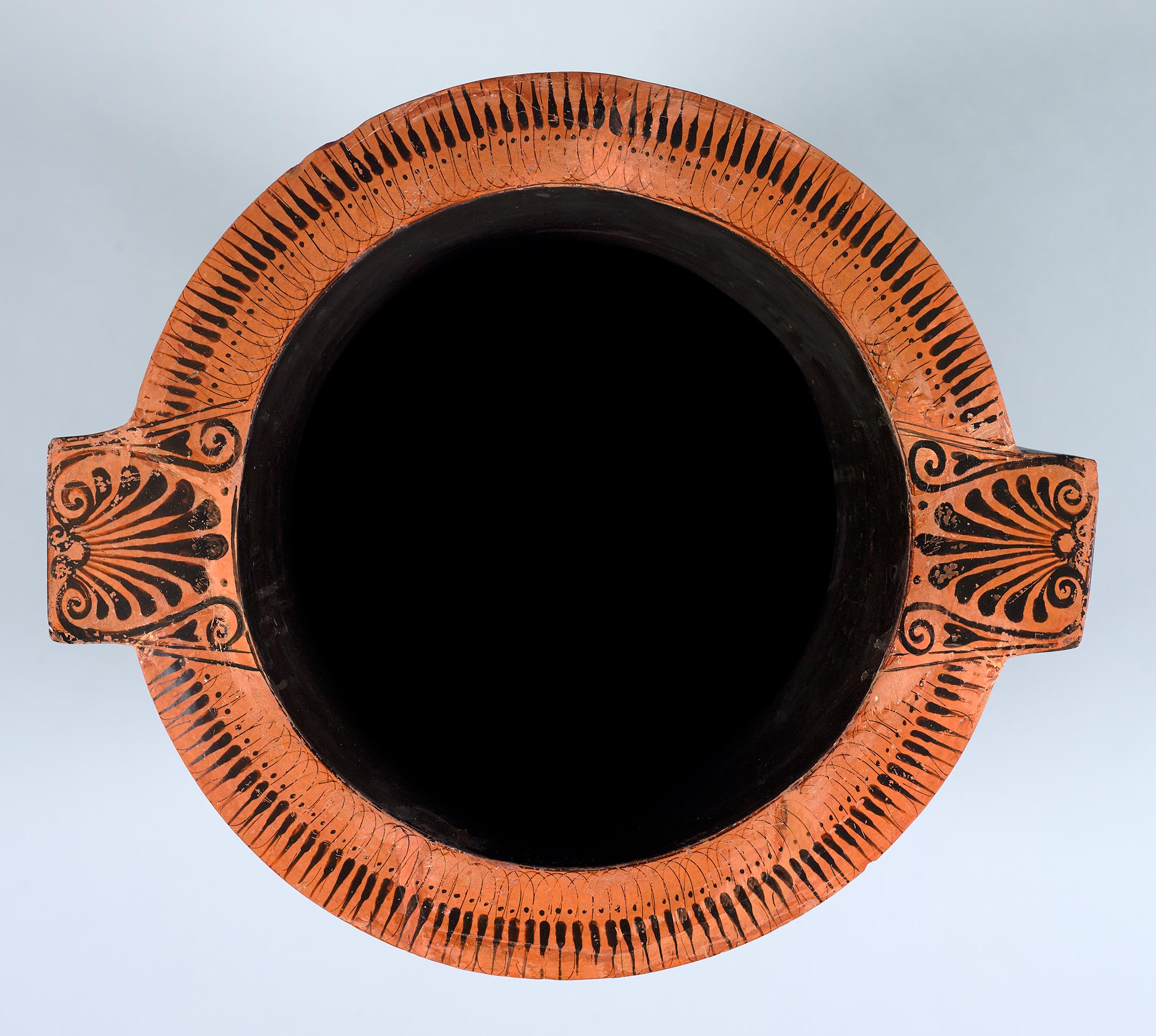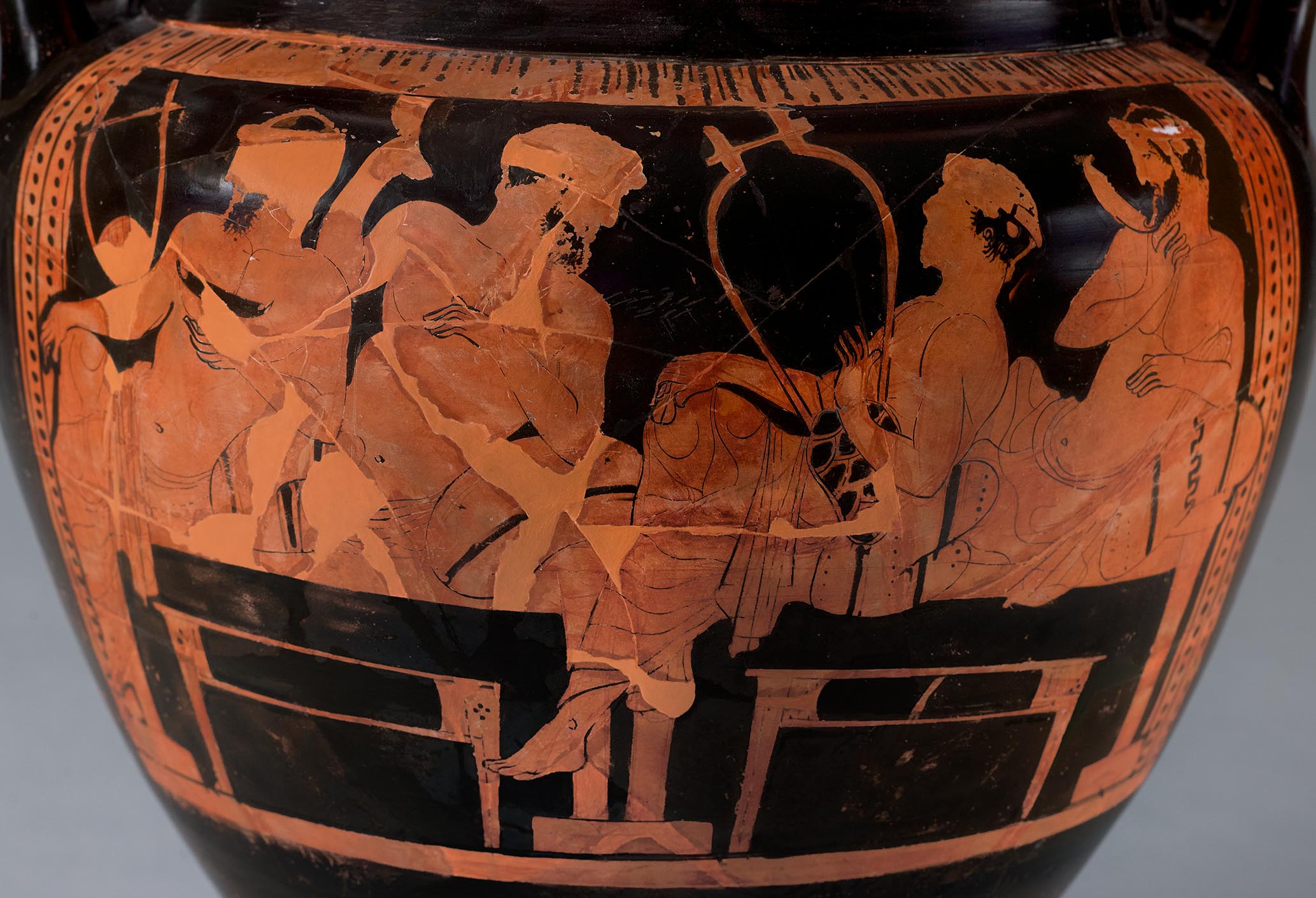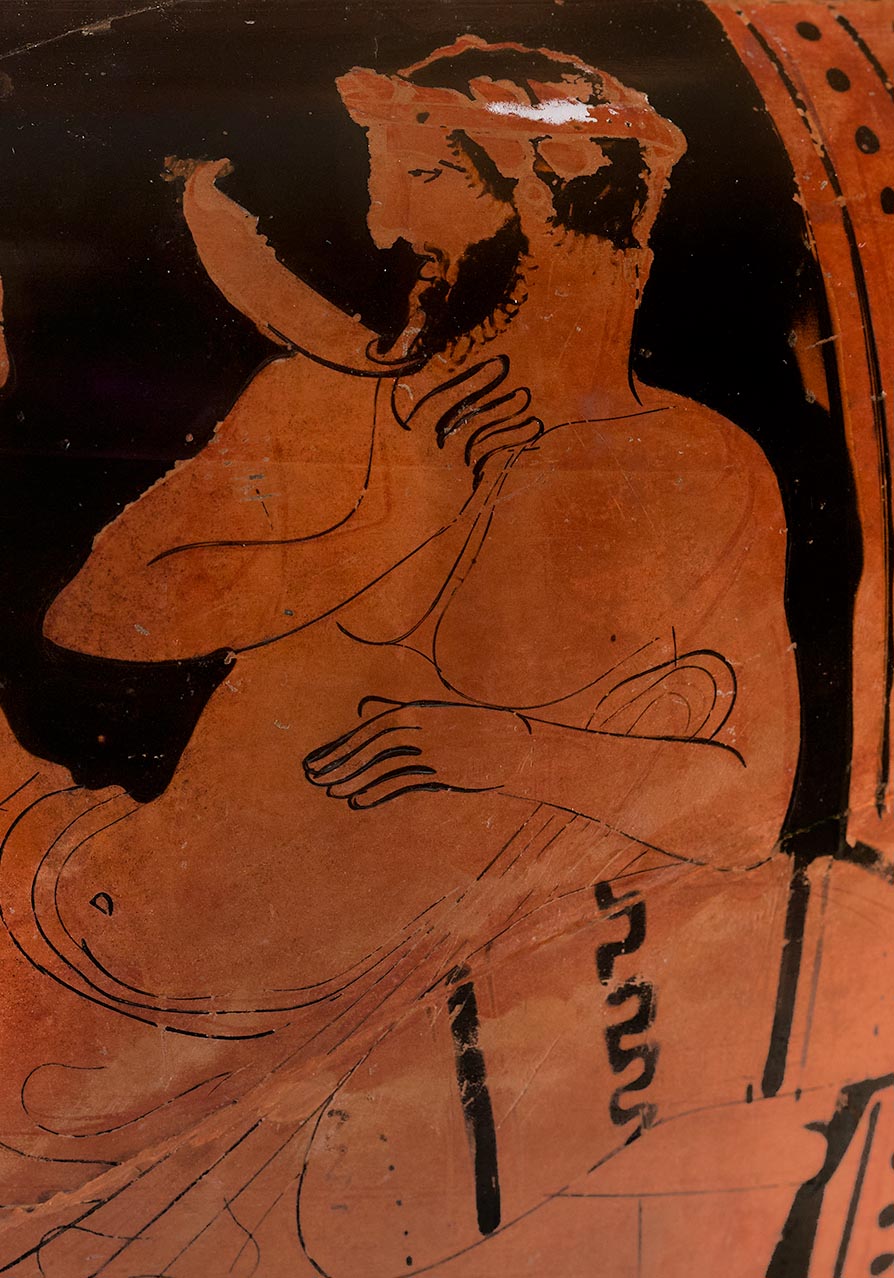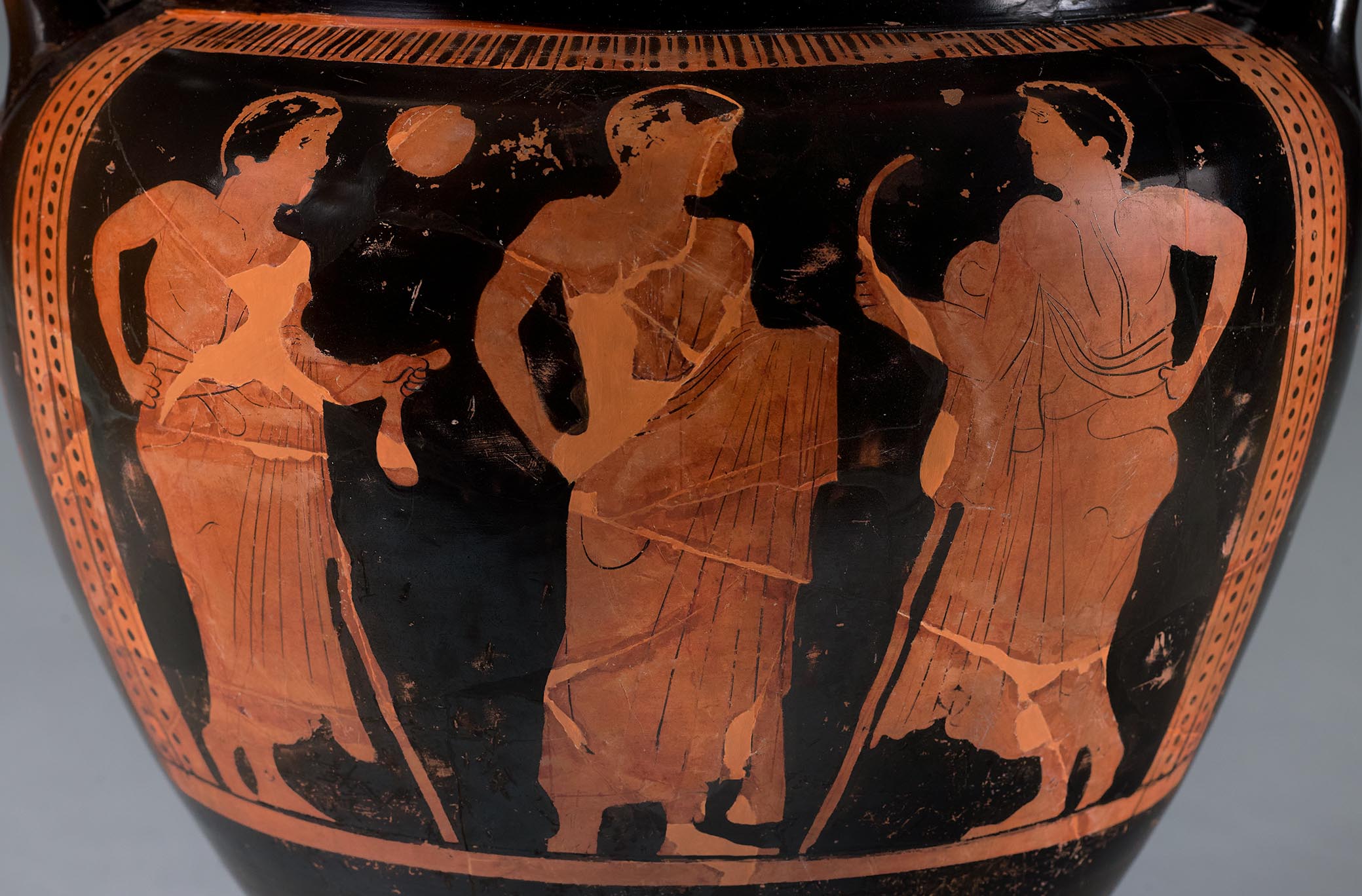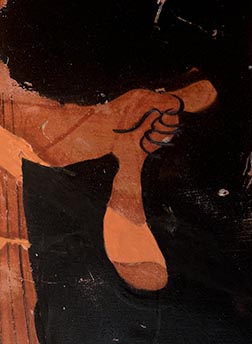Provenance
1890, gift, William Cowper Prime to Princeton University. Said to have been found at Nola.
Shape and Ornament
Top of rim convex; vertical overhang flaring outward at the juncture with upper surface. Interior of rim and neck black. Chain of lotus buds on top of rim; band of degenerate “ivy” leaves on overhang, with the leaves rendered as black dots. Flat handle plate extending beyond the rim at each side supported by two black “columns.” Black palmettes on top of handle plates with reserved hearts and eleven fronds. Frieze of pendant lotus buds on neck of side A. Ovoid body, interior painted a matte black, possibly in modern times. Figural panels on body framed above by black tongues, laterally by “ivy” vines. Slender reserved stripes for groundlines. Zone of rays extends from fillet separating body and foot. Torus foot in two degrees; groove separating torus from upper degree; underside reserved.
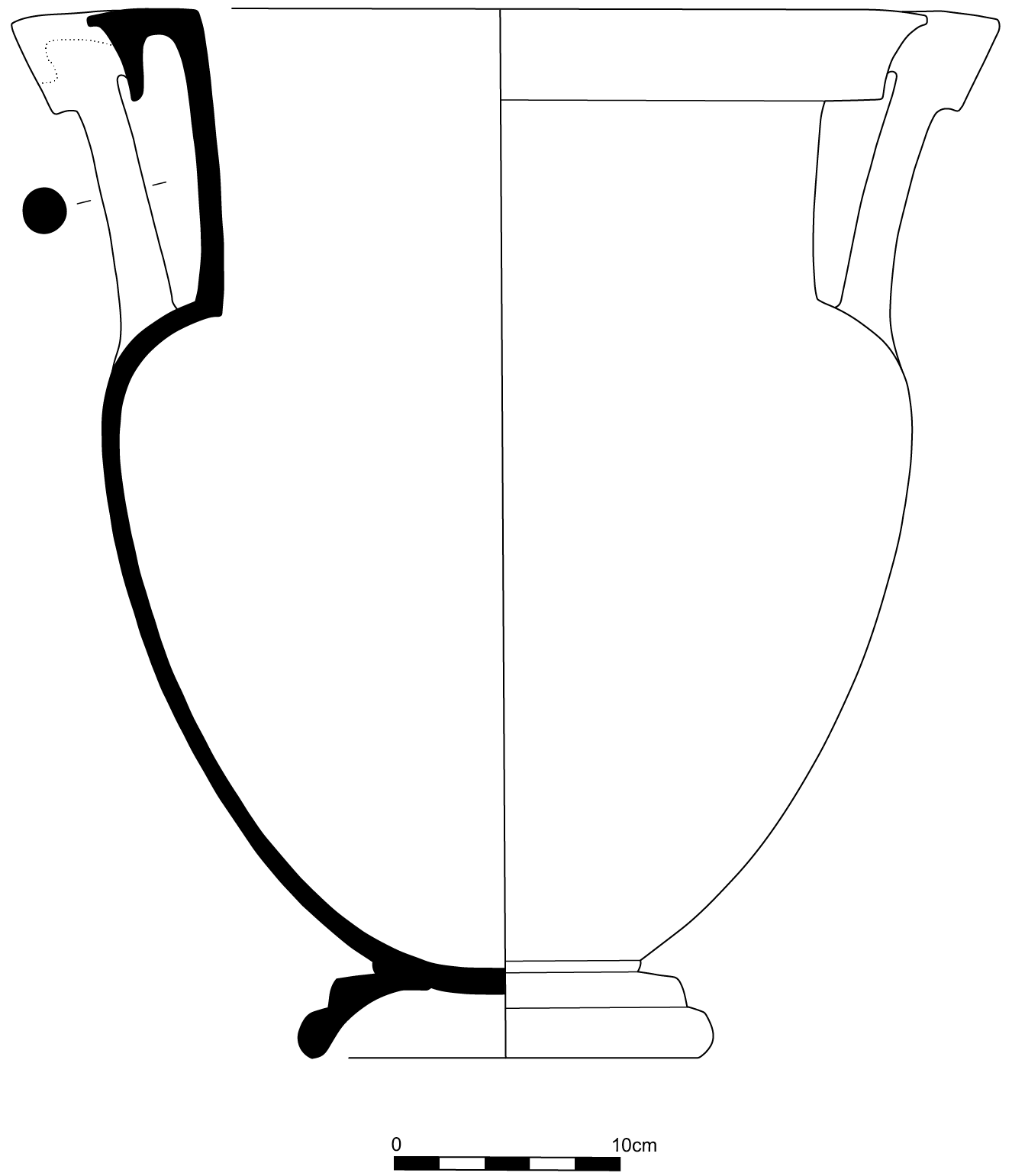
Subject
A. Symposion. Four banqueters recline in pairs on two couches. Each figure rests on a patterned cushion and wears a himation around his lower body, exposing his torso, as well as a tubular cloth fillet in his hair stuffed with herbs or flowers. A small, three-legged table stands in front of each of the couches. On the couch at right, a beardless youth, his head and body in profile to the left, holds a barbitos (tortoise-shell lyre) in his left hand and a plektron in his right, which rests on his raised right knee. The youth’s left leg dangles off the edge of the couch. His companion, an older, bearded man, his head in profile to the left and his body in three-quarter view, has hooked his right index finger in the handle of a stemless kylix, which he holds beside his chin in preparation for a kottabos toss. The man leans on his left elbow and appears to raise his right knee slightly. The pair on the couch at the left consists of two bearded men. The man at the far left, his head in profile to the left and his body frontal, dangles his left leg off the edge of the couch. He holds a black kylix by the stem in his left hand before his chest and rests his right hand on his bent knee. A lyra (lyre) hangs behind his right arm. His companion rests on his left elbow as he holds up a kylix in his right hand to make a kottabos toss. With his body frontal, he turns his head in profile to the right to look at the banqueters on the other couch.
B. Three beardless mantle figures. The youth at the right, facing left, leans on his staff, his lower body in profile and his bare back turned toward the viewer. His himation covers his lower body and is pulled up under his left arm as padding for the staff. With his left hand he holds out a strigil toward the youth at center, as though offering it to him. The middle boy, with his face in profile to the right and his body frontal, meets the other’s gaze and lifts his left hand toward him, though it remains wrapped in the himation covering his lower body. The youth at the left, his face in profile to the right and his body frontal, faces the other figures and leans on a staff, his right hand on his hip. A himation covers his lower body and exposes his torso. In his left hand he holds a purse, perhaps containing another gift for the boy in the center. A round object, possibly a sponge, hangs between the heads of the two figures at left. All three youths wear a white fillet in their short hair, now worn.
Attribution and Date
Attributed to the Hephaistos Painter [J. D. Beazley]. Circa 460 BCE.
Dimensions and Condition
h. 46.5 cm; w. 44.1 cm; diam. of mouth 39.0 cm; diam. of foot 18.6 cm. Broken and mended, with missing pieces restored in plaster, the painting of which is now largely effaced. Small hole in body underneath handle BA. Handles reattached. Most of the decoration is extant, with significant losses limited to the face and head of the leftmost symposiast, and portions of the torsos of the two figures at left on side B. Details of the decoration quite worn, with the face of the symposiast at the far right being the best preserved. In a previous repair, the edges of many fragments were brutally filed, with consequent damage to the gloss adjacent to the cracks.
Technical Features
Preliminary sketch. Relief contours used throughout on side A, sparingly on side B. Accessory color. White: fillets on side B. Dilute gloss: abdominal musculature, visible on the symposiast at the far right.
Inscriptions
Incised graffiti under foot:
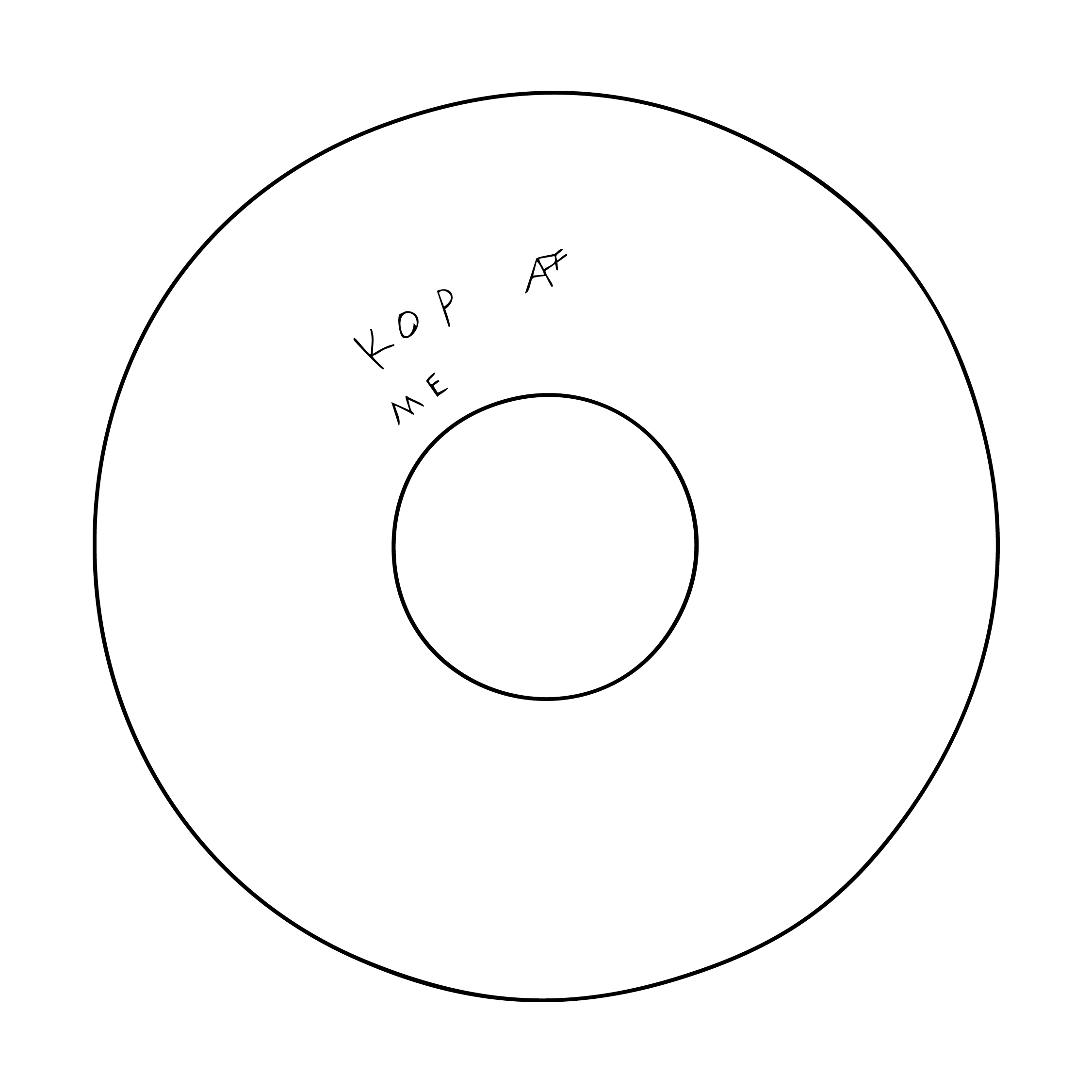
Bibliography
Abbreviation: ARV2J. D. Beazley. Attic Red-Figure Vase-Painters. 2nd ed. Oxford, 1963 1115.28; Abbreviation: Johnston, TrademarksJohnston, A. W. 1979. Trademarks on Greek Vases. Warminster: Aris and Philips., 133, no. 67, 135, no. 21, 148, no. 4, 167, no. 4; Abbreviation: Mannack, Late ManneristsT. Mannack. The Late Mannerists in Athenian Vase-Painting. Oxford, 2001, 132, no. H.27; Abbreviation: BAPDBeazley Archive Pottery Database. http://www.beazley.ox.ac.uk 214753.
Comparanda
For the Hephaistos Painter, see Abbreviation: ARV2J. D. Beazley. Attic Red-Figure Vase-Painters. 2nd ed. Oxford, 1963 1113–16, 1683–84, 1703; Abbreviation: ParalipomenaJ. D. Beazley. Paralipomena: Additions to Attic Black-Figure Vase-Painters and to Attic Red-Figure Vase-Painters. Oxford, 1971 452–53; Abbreviation: BAdd2Carpenter, T. H., ed. 1989. Beazley Addenda: Additional References to ABV, ARV2, and Paralipomena. 2nd ed. Oxford: Published for the British Academy by Oxford University Press. 330; E. F. Bloedow, T. Mannack, and K. Johnston-Mierins, “An Attic Red-Figured Column Krater by the Hephaistos Painter,” Abbreviation: EchClEchos du monde classique 30 (1991): 229–35; Abbreviation: Robertson, Art of Vase-PaintingM. Robertson, The Art of Vase-Painting in Classical Athens. Cambridge, 1992, 216–17; Abbreviation: Mannack, Late ManneristsT. Mannack. The Late Mannerists in Athenian Vase-Painting. Oxford, 2001, 33–36; K. Schauenburg, “Zu einigen Vasen in Privatbesitz,” in Bildergeschichte: Festschrift Klaus Stähler, ed. J. Gebauer (Möhnesee, 2004), 429–41. For a close parallel of the symposion scene, cf. a column-krater by the Hephaistos Painter in the Guido Grimaldi Collection, London (Günter Puhze, Kunst der Antike 7 [Freiburg, 1987], no. 193). The symposion was a popular scene among the Mannerists, and the banquet on Princeton’s vase broadly resembles many others from the workshop: e.g., by the Leningrad Painter, a column-krater in Milan, Banca Intesa 354 (Abbreviation: ARV2J. D. Beazley. Attic Red-Figure Vase-Painters. 2nd ed. Oxford, 1963 567.4; Abbreviation: BAPDBeazley Archive Pottery Database. http://www.beazley.ox.ac.uk 206491); by the Duomo Painter, Bari 6252 (Abbreviation: ARV2J. D. Beazley. Attic Red-Figure Vase-Painters. 2nd ed. Oxford, 1963 1118.14; Abbreviation: BAPDBeazley Archive Pottery Database. http://www.beazley.ox.ac.uk 214792). For the figural style, in addition to the comparanda for the sympotic scenes (supra), cf. the name-vase of the Hephaistos Painter, Naples H 2412 (Abbreviation: ARV2J. D. Beazley. Attic Red-Figure Vase-Painters. 2nd ed. Oxford, 1963 1114.1; Abbreviation: BAPDBeazley Archive Pottery Database. http://www.beazley.ox.ac.uk 214726); and another column-krater by the artist, Ferrara 2672 (Abbreviation: ARV2J. D. Beazley. Attic Red-Figure Vase-Painters. 2nd ed. Oxford, 1963 1114.11; Abbreviation: BAPDBeazley Archive Pottery Database. http://www.beazley.ox.ac.uk 214737). Distinctive features include the scraggly beards, two parallel lines for the breastbone, and eyes consisting of open triangles with two lines for the upper lid, all of which can be seen on the symposiast at the far right on Princeton’s krater.
The column-krater was the most popular shape among the Late Mannerists, developing the shape as decorated by Myson, the first painter of red-figure column-kraters. For a discussion of the shape within the work of Myson and the Earlier Mannerists, see W. G. Moon and L. Berge, Greek Vase-Painting in Midwestern Collections (Chicago, IL, 1979), 168–70. For the development of the shape within the Late Mannerist Workshop, see Abbreviation: Mannack, Late ManneristsT. Mannack. The Late Mannerists in Athenian Vase-Painting. Oxford, 2001, 50–56. For the ornament on the rim, neck, and body, all of which are canonical for the period, cf., inter alia, Cambridge, Fitz. GR 1.1950, also by the Hephaistos Painter (Abbreviation: ARV2J. D. Beazley. Attic Red-Figure Vase-Painters. 2nd ed. Oxford, 1963 1115.24; Abbreviation: Mannack, Late ManneristsT. Mannack. The Late Mannerists in Athenian Vase-Painting. Oxford, 2001, 131, no. H.24; Abbreviation: BAPDBeazley Archive Pottery Database. http://www.beazley.ox.ac.uk 214750). For the palmettes on the handle plates, with reserved hearts and eleven petals, cf., also by the Hephaistos Painter, Bari 4980 (Abbreviation: ARV2J. D. Beazley. Attic Red-Figure Vase-Painters. 2nd ed. Oxford, 1963 1115.26; Abbreviation: Mannack, Late ManneristsT. Mannack. The Late Mannerists in Athenian Vase-Painting. Oxford, 2001, 132, no. H.26; Abbreviation: BAPDBeazley Archive Pottery Database. http://www.beazley.ox.ac.uk 214752). Such palmettes, it should be noted, are not unique to the Hephaistos Painter, but also appear commonly in related works by the Duomo Painter: e.g., Ferrara 3005 (Abbreviation: ARV2J. D. Beazley. Attic Red-Figure Vase-Painters. 2nd ed. Oxford, 1963 1118.17; Abbreviation: BAPDBeazley Archive Pottery Database. http://www.beazley.ox.ac.uk 214795).
For the iconography of the symposion, see J.-M. Dentzer, Le motif du banquet couché dans le Proche-Orient et le monde grec du VIIe au IVe siècle avant J.-C. (Rome, 1982); Abbreviation: Lissarrague, Greek BanquetF. Lissarrague. The Aesthetics of the Greek Banquet: Images of Wine and Ritual. Translated by A. Szegedy-Maszak. Princeton, 1990; K. Topper, The Imagery of the Athenian Symposium (Cambridge, UK, 2012). For the use of stringed instruments in the symposion, see Abbreviation: Bundrick, Music and ImageS. D. Bundrick. Music and Image in Classical Athens. Cambridge, 2005, 14–18. For the game of kottabos, see B. Sparkes, “Kottabos: An Ancient After-Dinner Game,” Archaeology 13 (1960): 202–7; N. Hösch, “Das Kottabosspiel,” in Abbreviation: Kunst der SchaleKunst der Schale, Kultur des Trinkens: Ausstellung der attischen Kleinmeisterschalen des 6. Jahrhunderts v. Chr. Edited by K. Vierneisel, B. Kaeser, and B. Fellmann. Munich, 1990, 272–75; E. Csapo and M. C. Miller, “The Kottabos-Toast and an Inscribed Red-Figured Cup,” Abbreviation: HesperiaHesperia: The Journal of the American School of Classical Studies at Athens 60 (1991): 367–82.
For the mantle figures on side B, with their gently curving elbows and seemingly stunted fingers, cf. the Hephaistos Painter’s name-vase in Naples (supra); Milan 3643.23Sp (Abbreviation: ARV2J. D. Beazley. Attic Red-Figure Vase-Painters. 2nd ed. Oxford, 1963 1115.25; Abbreviation: Mannack, Late ManneristsT. Mannack. The Late Mannerists in Athenian Vase-Painting. Oxford, 2001, 132, no. H.25, pl. 30; Abbreviation: BAPDBeazley Archive Pottery Database. http://www.beazley.ox.ac.uk 214751); London E 477 (Abbreviation: ARV2J. D. Beazley. Attic Red-Figure Vase-Painters. 2nd ed. Oxford, 1963 1114.15; Abbreviation: Mannack, Late ManneristsT. Mannack. The Late Mannerists in Athenian Vase-Painting. Oxford, 2001, 131, no. H.15, fig. 4.6 [drawing]; Abbreviation: BAPDBeazley Archive Pottery Database. http://www.beazley.ox.ac.uk 214741); formerly Agrigento, Giudice 143 (Abbreviation: ARV2J. D. Beazley. Attic Red-Figure Vase-Painters. 2nd ed. Oxford, 1963 1114.6 Abbreviation: Mannack, Late ManneristsT. Mannack. The Late Mannerists in Athenian Vase-Painting. Oxford, 2001, 130, no. H.6, pl. 28; Abbreviation: BAPDBeazley Archive Pottery Database. http://www.beazley.ox.ac.uk 214731). On the name-vase can also be found the closest parallel for the figure with his back turned to the viewer, with the spine drawn as a double line with a bulge in the center. Although it is very common for the Hephaistos Painter to decorate the reverse side of his column-kraters with three draped youths, the number can vary between two and four youths, with single draped figures only rarely depicted.
The most common accoutrements held by mantle figures are staffs and strigils. There are only two other vases by the Hephaistos Painter that show a youth holding a purse: Krakow 1473 (Abbreviation: ARV2J. D. Beazley. Attic Red-Figure Vase-Painters. 2nd ed. Oxford, 1963 1116.44; Abbreviation: BAPDBeazley Archive Pottery Database. http://www.beazley.ox.ac.uk 214770); and Agrigento 22276 (L. Braccesi, L. Franchi dell’Orto, and R. Franchi, eds., Veder Greco: Le necropolis di Agrigento, exh. cat. [Rome, 1988], 379, no. 1; Abbreviation: BAPDBeazley Archive Pottery Database. http://www.beazley.ox.ac.uk 31412). Both scenes are domestic in nature, with seated women intermingling with draped youths. Money purses, which occur in many commercial scenes where their contents are not in doubt, are distinguishable from other kinds of bags by their plainness and small size: see M. Meyer, “Männer mit Geld,” Abbreviation: JdIJahrbuch des Deutschen Archäologischen Instituts 103 (1988): 87–125. They do not resemble the net bags that hang in many scenes, containing black dots that could be anything from balls to nuts; for these, see D. Williams, CVA London 9 (Great Britain 17), 52. The distinction is made clear on a cup by Makron, where men offer purses to women while a net bag hangs in the background with a sponge and strigil: Toledo 72.55 (CVA Toledo 1 [USA 17], pls. 53.1–2, 54.1–2; Abbreviation: BAPDBeazley Archive Pottery Database. http://www.beazley.ox.ac.uk 7766). The transactional nature of such interactions is occasionally made explicit, as on a lekythos by the Oionokles Painter, where a man offers a boy a coin from the purse that he holds open in his hand: Atlanta 2001.28.1 (J. Gaunt, “New Galleries of Greek and Roman Art at Emory University: The Michael C. Carlos Museum,” Minerva 16.1 [2005]: 15, fig. 11; Abbreviation: BAPDBeazley Archive Pottery Database. http://www.beazley.ox.ac.uk 9024559). It has been suggested that purses offered to boys or women might contain astragaloi (knucklebones): G. F. Pinney, “Money-Bags?” Abbreviation: AJAAmerican Journal of Archaeology 90 (1986): 218; G. Ferrari, Figures of Speech: Men and Maidens in Ancient Greece (Chicago, IL, 2002), 14–17. Astragaloi, however, had their own container, the phormiskos (Plato, Lysis 206e), a bag resembling a purse, but longer and with a flapped aperture on the side secured with a string: for a clear example, described by Beazley (L. D. Caskey and J. D. Beazley, Attic Vase Paintings in the Museum of Fine Arts, Boston [Oxford, 1963], 3:67), see the interior of Boston 21.4 (Abbreviation: ARV2J. D. Beazley. Attic Red-Figure Vase-Painters. 2nd ed. Oxford, 1963 1259.11; Abbreviation: BAPDBeazley Archive Pottery Database. http://www.beazley.ox.ac.uk 217081); cf. also Princeton 2002-40 (Entry 8). Phormiskoi are often depicted in conjunction with a writing tablet, another signifier of youth: e.g., Mykonos 110 (Abbreviation: ARV2J. D. Beazley. Attic Red-Figure Vase-Painters. 2nd ed. Oxford, 1963 1280.68; Abbreviation: BAPDBeazley Archive Pottery Database. http://www.beazley.ox.ac.uk 216256); Oxford 1928.573 (Abbreviation: ARV2J. D. Beazley. Attic Red-Figure Vase-Painters. 2nd ed. Oxford, 1963 920.15; Abbreviation: BAPDBeazley Archive Pottery Database. http://www.beazley.ox.ac.uk 211185); New York art market (Christie’s, Antiquities, auc. cat., June 5, 1998, New York, NY, lot 139).
As for the graffiti on the underside of the foot, Johnston (Trademarks, 213) rejects Amyx’s suggestion that ME graffiti are abbreviations of megaloi, and thus qualify the KOP, which references the shape of the column-krater: D. A. Amyx, “The Attic Stelai: Part 3; Vases and Other Containers,” Abbreviation: HesperiaHesperia: The Journal of the American School of Classical Studies at Athens 27 (1958): 198. Such qualifying adjectives are rare, and other vases bearing the same graffito are of a size that cannot be considered large: e.g., the cup-skyphos Berlin 2081 (Abbreviation: ABVJ. D. Beazley. Attic Black-Figure Vase-Painters. Oxford, 1956 567.635; Abbreviation: BAPDBeazley Archive Pottery Database. http://www.beazley.ox.ac.uk 331733). The mark AP belongs in Johnston’s type 9E (Trademarks, 130–35).
